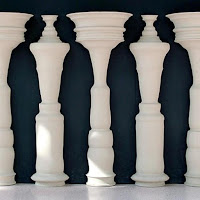Pillars of Gestalt:
• Field Theory: The person's experience is explored in the context of their situation or field.
• Phenomenology: The search for understanding through what is obvious and what is revealed, rather than what is interpreted.
• Dialogue: A specific form of contacting (not just talking) that is concerned with the between of the relationship and what emerges in that between.
These philosophies can weave in and out of each other. Gestalt is a 'voyage of discovery' - exploring how a person reaches out to the world, how they respond to an image and how past and present situations impact upon their process of reaching out in the here and now.
Figure and Ground
• Many examples of the concept of figure and ground have been illustrated visually through diagrammatic examples.
• The image you gaze upon is the figure whilst the ground is everything that surrounds that image.
• Your experience, people around you, objects around you and your cultural background will all alter the ground.
• The ground profoundly affects how one sees the figure.
• Figure formation is of interest to gestalt therapists in terms of what figure the individual selects and how it is chosen.
• Past experiences, the here and now, a person's upbringing and background can alter which objects are seen first in clarity or blurriness.
Reflection
While I got the wrong book out of the library - I asked for one relating to gestalt theory rather than therapy - there was still some interesting content to be read in the introduction which can be used to informed my work int his module. Optical illusions and Op-Art are both incredibly interesting to me as someone with a visual impairment and I may propose to research them further in COP2 next year. This wasn't relevant to my essay or my work for this year though, so my notes are few and I had to reconsider the content I was reading! Time is ticking and I need to be selective.




No comments:
Post a Comment